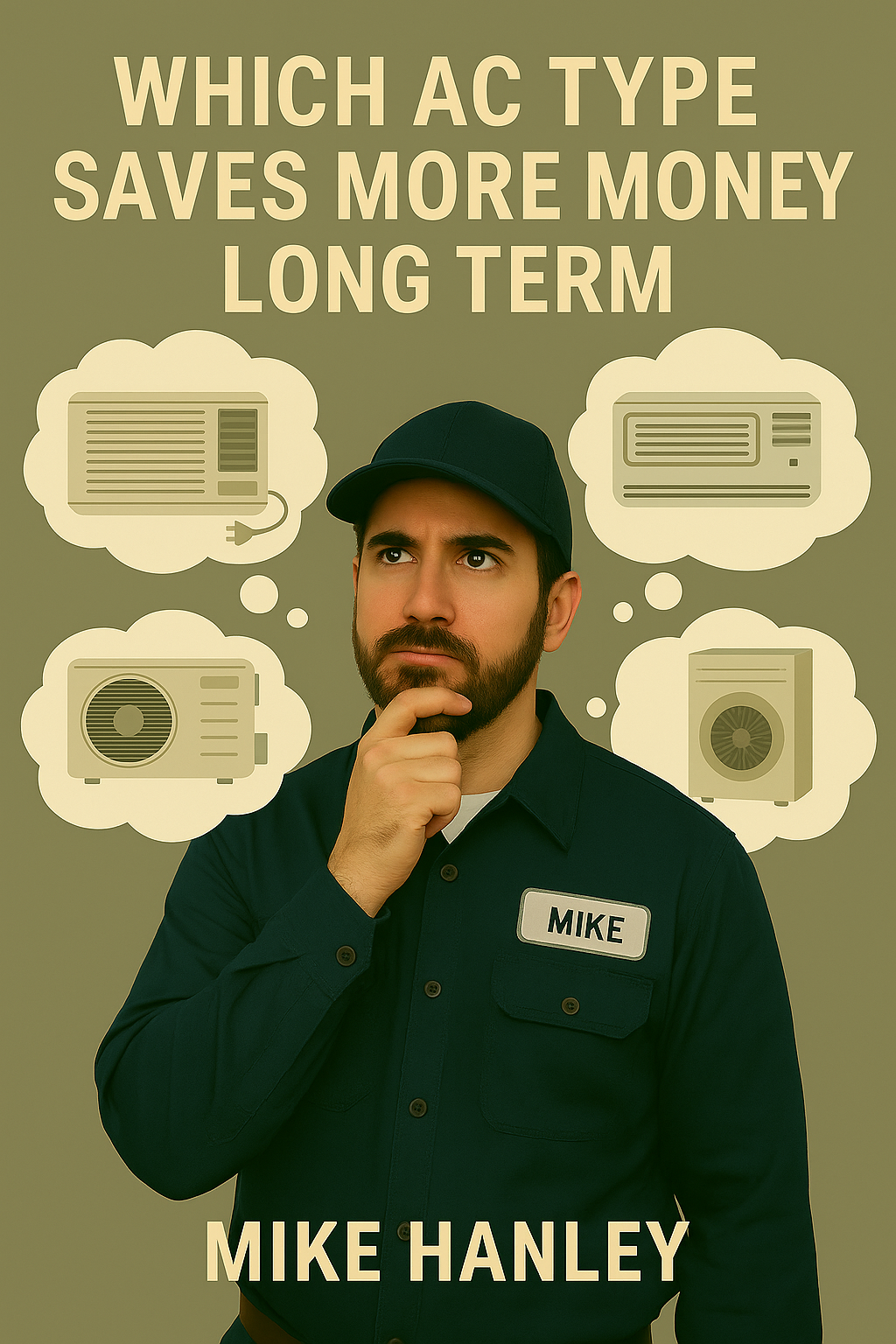📘 Table of Contents
- 🏠 Introduction: AC Efficiency Goes Beyond the Price Tag
- 💸 Upfront Costs Comparison
- ⚡ Energy Efficiency and Utility Bills
- 🔧 Maintenance and Repair Differences
- 📊 Real-Life Cost Scenarios
- 👀 Full AC Type Comparison
- ✅ Key Takeaways and Next Steps
- ❓ FAQ
🏠 AC Efficiency Goes Beyond the Price Tag
At first glance, it’s tempting to choose an AC based on the lowest price tag. But smart homeowners know that the real savings come down to efficiency, maintenance, and how long the unit lasts.
Whether you're comparing wall-mounted ACs, window units, or considering a mini-split, this guide breaks down what you’ll actually spend and save over time.
💸 Upfront Costs Comparison
Let’s start with what you’ll spend upfront. Window units win on price, but other types may offer better value long-term.
|
AC Type |
Average Unit Cost |
Installation Cost |
Accessories Needed |
|
Window Unit |
$150–$500 |
$0 (DIY install) |
Mounting brackets, seals |
|
Through-the-Wall |
$400–$1,200 |
$100–$400 (professional) |
Wall sleeve, sealant, tools |
|
Portable Unit |
$200–$700 |
$0 (DIY install) |
Hose kit, window adapter |
|
Mini-Split System |
$800–$2,500 |
$1,000+ (professional) |
Line sets, brackets, etc. |
|
Central AC (Small) |
$2,000–$5,000 |
$3,000+ (professional) |
Ductwork, thermostat |
🛒 Browse window units, wall ACs, and mini-splits available at The Furnace Outlet.
⚡ Energy Efficiency and Utility Bills
The right AC can save you hundreds per year on utilities. Here’s how they compare on energy use:
-
Window Units: Often leak air unless sealed properly. Entry-level models may lack energy-saving features.
-
Through-the-Wall Units: Better insulation and more secure installation reduce energy loss over time.
-
Mini-Splits: Most efficient option—especially for zoned setups and Energy Star-rated models.
-
Portable ACs: Typically the least efficient due to heat discharge and single-room cooling.
-
Central ACs: Efficient when ductwork is in good shape, but more costly to operate.
📈 According to Energy Star, upgrading to certified models with programmable features can reduce cooling costs by 10–30%.
🔧 Maintenance and Repair Differences
All ACs need regular care, but how often and how complex that care is can affect your long-term costs.
-
Window Units: Shorter lifespan and more prone to seasonal wear from being removed and reinstalled.
-
Wall Units: Longer-lasting with fewer disruptions after initial setup.
-
Portable Units: Require more frequent drainage and filter changes.
-
Mini-Splits: Reliable but must be professionally serviced and cleaned.
-
Central ACs: Need annual inspections and duct maintenance to run efficiently.
🧰 Use our AC maintenance kits and replacement filters to keep your unit in top condition.
📊 Real-Life Cost Scenarios
Here’s a 5-year example comparing a window AC user vs. a wall AC user:
|
Category |
Window AC User |
Wall AC User |
|
Upfront Cost |
$300 |
$800 |
|
Energy Bills |
~$80/month |
~$65/month |
|
Maintenance |
Filter & coil clean |
Filter & coil clean |
|
Lifespan |
6 years average |
10+ years average |
|
Estimated Total |
~$5,100 |
~$4,700 |
💬 Bottom line: While wall units cost more initially, they can save hundreds in the long run.
👀 Full AC Type Comparison
Here’s a big-picture view of how each system stacks up in performance, value, and install needs:
|
Type |
Upfront Cost |
Efficiency |
Install Effort |
Long-Term Value |
|
Window Unit |
✨ Low |
❄ Fair |
✅ Easy |
⚠ Short lifespan |
|
Wall Unit |
🔁 Mid |
❄️ Good |
⚖ Moderate |
⭐ Reliable |
|
Portable Unit |
✨ Low |
⚠ Poor |
✅ Easy |
❌ Low savings |
|
Mini-Split |
🔥 High |
⭐ Excellent |
⚖ Pro Required |
🌟 Long-term win |
|
Central AC |
🚫 Very High |
💡 High |
🤞 Complex |
📈 Best for whole homes |
For details on system types and installation, see Consumer Reports’ AC buying guide.
✅ Key Takeaways and Next Steps
If your goal is to save money in the long run, not all AC types are created equal.
-
Mini-splits and wall units offer the best combo of efficiency and longevity.
-
Window units may be cheap upfront, but they can cost more over time.
-
Portable ACs are convenient but rarely pay off in energy savings.
-
Central ACs are ideal for full-home comfort but carry the highest cost.
🔙 Back to Main Topic: Through-the-Wall AC vs Window Unit
➡️ Also Read: Why Window AC Units Are Still a Popular Cooling Choice
➡️ Also Read: Pros and Cons of Through the Wall AC Units
❓ FAQ
Q: Which AC type saves the most money long term?
A: Mini-splits often save the most in energy costs and maintenance, followed by wall units. Window and portable units cost less upfront but often cost more to run.
Q: Can I reduce AC bills with a smart thermostat?
A: Absolutely. Smart thermostats help you schedule use, avoid overcooling, and control temperatures remotely. Check for compatibility before buying.
Q: Are portable ACs a good investment?
A: Only for short-term or emergency cooling. They’re the least efficient and often noisier than other options.
Q: Is it worth paying for a mini-split system?
A: Yes—especially if you need zone-based cooling, high efficiency, and long-term reliability. They’re more expensive upfront but offer strong ROI.
Q: What’s the best AC for small apartments?
A: Window or wall units work well, depending on whether you want portability or permanence. The Spruce offers tips on choosing the right size.







